Table of Contents
A few months ago I spent a day testing different weights in my panniers to determine how those differences would affect my travelling speed. On one test run, I decided to use front instead of rear panniers and realised there was a speed difference. It worked out to be around five minutes on a hilly 100km ride or the equivalent of carrying five fewer kilograms.
That experience spurred on the idea to determine the aerodynamic differences between front panniers, rear panniers, both panniers, and bikepacking bags on a velodrome. I decided to go around in circles until I’d gathered enough data, using a power meter to ensure that my effort was consistent from start to finish.
This isn’t an exact science, I know, but it’s the best I can do without having access to a wind tunnel!
The Experiment
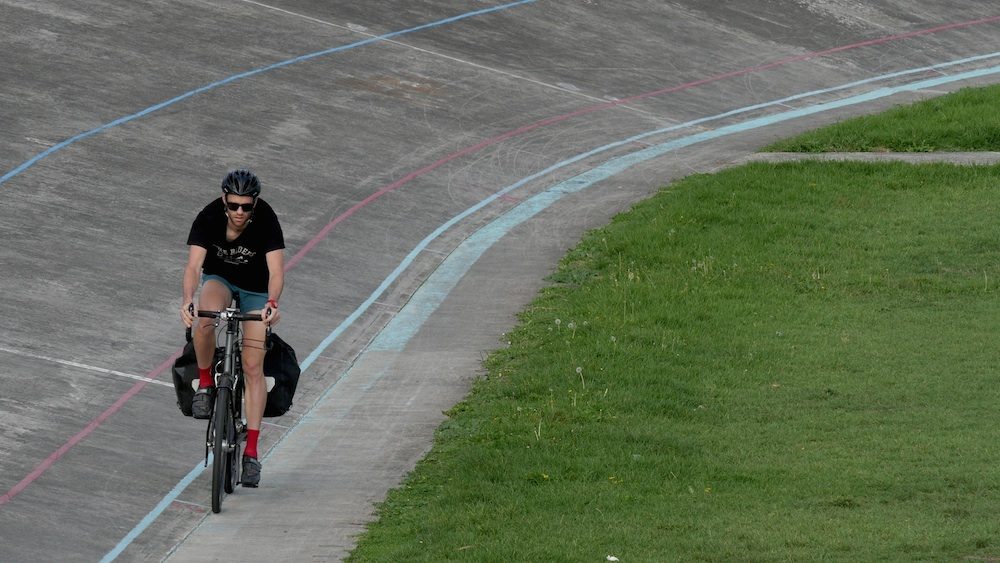
I used an outside velodrome in Melbourne (AUS) as my testing ground. The velodrome is precisely 320.622m long and actually has one metre of up and down for every lap. There was a slight breeze coming from the south but it didn’t seem to change throughout the day.
The bike I used was my Surly Long Haul Trucker touring bike. It weighs precisely 15kg and has Schwalbe Marathon Mondial 40mm tyres installed. I fitted a Stages power meter crank arm to keep my effort of 200w in check. I wore casual clothes, as that is generally my preference on a bike tour.
I tested four different bag configurations on the velodrome. I used Ortlieb Back-Roller Plus 21L panniers for both the front and rear pannier testing. When testing both front and rear sets, I used the Back-Rollers on the rear rack and added some Sport-Rollers to the front. My bikepacking kit consisted of a Revelate 12L seatpack, half frame pack, top tube pack and handlebar harness with drybag. The overall weight for all setups was identical.
All of my test runs had a rolling start and were conducted in the same gear from start to finish. My power fluctuated up a little on one side of the velodrome, and down on the other, presumably due to the elevation changes.
I initially completed 10 laps (~3.2km/2mi) with each bag setup. I then re-tested for another 10 laps with each setup to ensure that my times were consistent. The average speeds and times below are based on all 20 laps for each bag setup.
What about fatigue?
Here’s the deal; I got fatigued, but that didn’t affect the results. How? I picked a power that I knew I could push all day long, so even as I was getting gradually more tired after each test run, the pressure I put through the pedals remained the same from start to finish.
Results
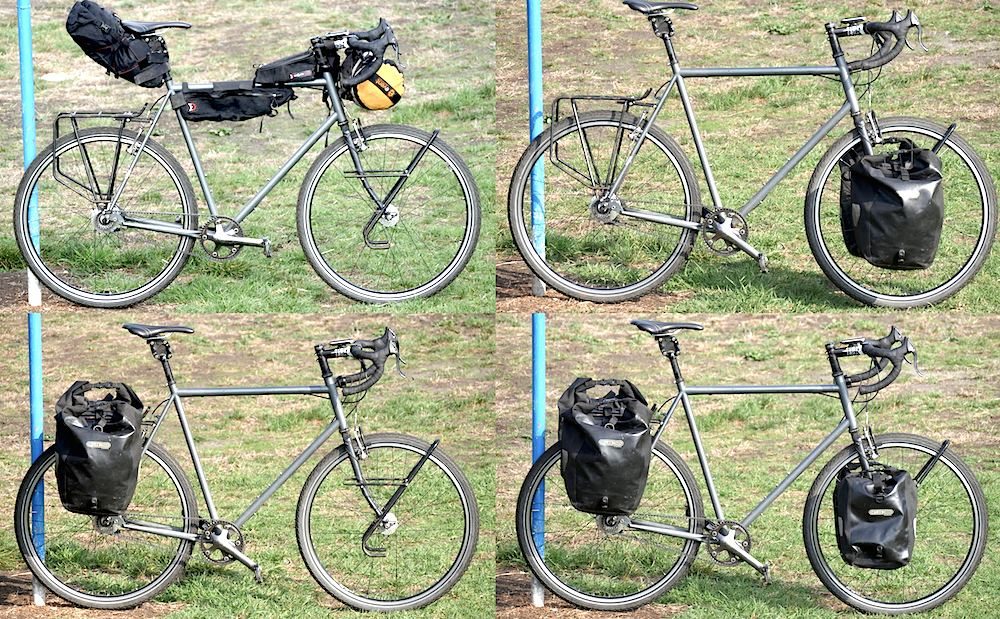
Bikepacking Bags – 20 laps @ 200.5w Average Power
38.262 seconds av per lap
119.34 seconds av per kilometre
30.17km/h average speed
Extrapolated Time for a 100km (62mi) Ride: 3:18:54
Rear Pannier Bags Only – 20 laps @ 199.5w Average Power
40.931 seconds av per lap
127.66 seconds av per kilometre
28.20km/h average speed
Extrapolated Time for a 100km (62mi) Ride: +12 minutes (6.5% slower)
Front Pannier Bags Only – 20 laps @ 199w Average Power
40.89 seconds av per lap
127.54 seconds av per kilometre
28.23km/h average speed
Extrapolated Time for a 100km (62mi) Ride: +12 minutes (6.4% slower)
Both F+R Pannier Bags – 20 laps @ 200w Average Power
41.542 seconds av per lap
129.57 seconds av per kilometre
27.78km/h average
Extrapolated Time for a 100km (62mi) Ride: +17 minutes (7.9% slower)
Analysis
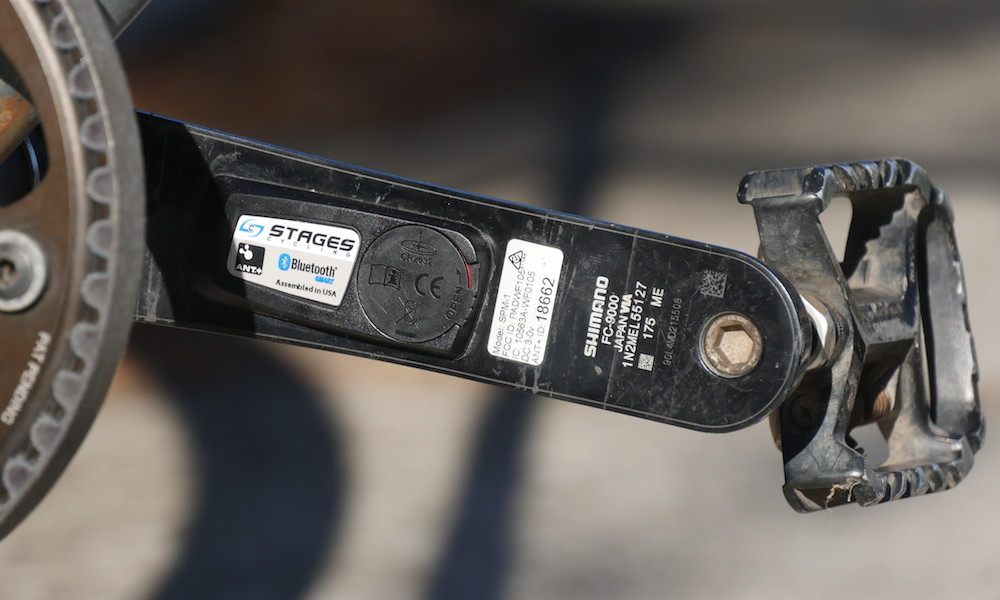
The effects of aerodynamic drag turned out to be quite significant. Using two panniers on either the front or rear slowed my speed by about 6.5% while running both sets at the same time stretched that out to 7.9%.
It’s reasonable to extrapolate this data because the number of laps I completed on the velodrome should balance out many external influences. It was reassuring that after completing 10 laps and re-testing for another 10 laps that I was within a couple of seconds each time. Should I have completed more laps on the velodrome, there would have been the risk of greater changes in the weather, which wouldn’t have provided a fair comparison between each of the loads that I was carrying.
It’s interesting that there’s very little difference between using front vs rear panniers. While you’d assume that having the front panniers lower to the ground would reduce the effects of aerodynamic drag, my testing demonstrated that the difference is negligible.
As expected, adding a second set of panniers to my bike slowed it down a further 0.5km/h.
How Significant Are Aerodynamics?

It’s pretty big.
Aerodynamics has a significant impact on your speed, especially when compared to my weight testing. On my hilly test course when carrying 20 extra kilograms it worked out to be 18 minutes slower over 100km. To put that into perspective, that time difference is essentially the same as the difference between bikepacking bags or four panniers with equal weight (17 minutes). That’s a lot!
A Few Thoughts on Aerodynamics
The more distance you’re looking to travel per day, the more aerodynamics matter.
If you’re planning on completing some big days on the bike, then your time savings will become greater and greater with bikepacking bags. For example, if you were riding 200km on a flat route, you could expect a 24 minute saving for the day given the same amount of effort.
The flatter your tour route – the more aerodynamics matter.
You move faster on flatter surfaces, so the effects of aerodynamic drag are greater. For a trip that traverses flat land, it makes even more sense to use bikepacking bags.
The hillier your tour route, or the more weight you have – the less aerodynamics matter.
Aerodynamics play a bigger role the faster you’re moving. As your average speed is reduced in the hills (or with more weight) the effects of aerodynamic drag will reduce too, and the overall time savings have less of an effect.
If you’re carrying bikepacking bags, you’re probably not on a touring bike and you probably have a lighter load.
If you’re using bikepacking bags on the road, you’re probably on a lighter weight bike, with slicker/narrower tyres, and in a more aerodynamic position. The time savings from your bag setup choice are just the beginning, really.
Summary
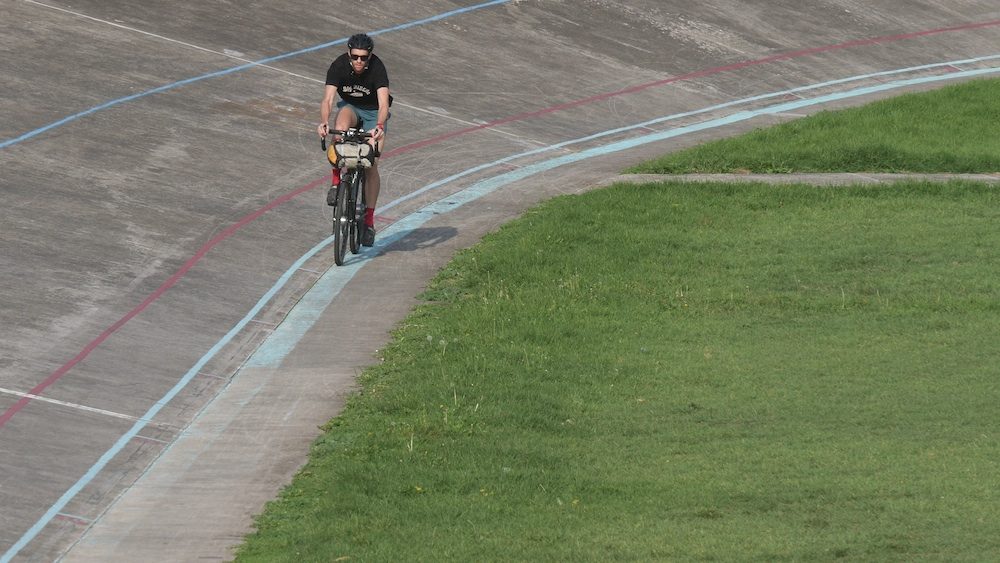
While this test is an interesting comparison between travelling speeds with different bag setups, you should ideally choose your bags based on the type of trip you’re doing. If you like carrying comfort items, or if you’re travelling for a long time – then panniers are going to be the most practical solution for you. But if you’re travelling light, you’ll have the option for either setup.
Alee, the aero savings are huge! Should I sell all my panniers?
Don’t do it! Panniers are awesome for bike travel as they’re:
– Quick to take on/off the bike
– Easy to carry off the bike
– Tough
– Waterproof
– Able to fit all kinds of objects
– Twice the capacity as a complete bikepacking kit (four panniers)
For those tours where you don’t need to carry as much gear, it’s hard to look past using a set of bikepacking bags. They’re light, fit to any bike and force you to pack light – the aero savings are really just the cream on top.
Click HERE For A List of Bikepacking Bag Manufacturers, and HERE For A List of Pannier Manufacturers


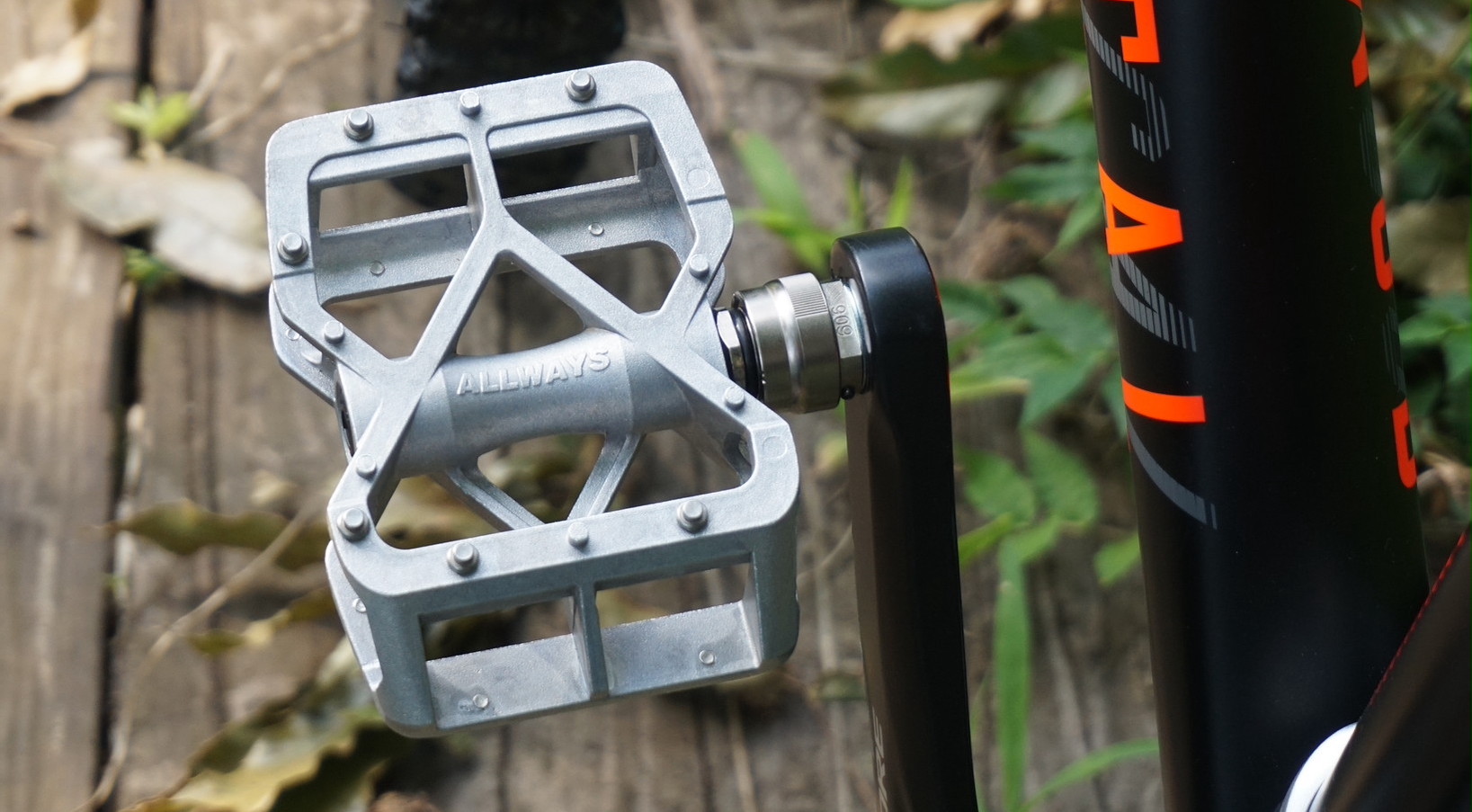
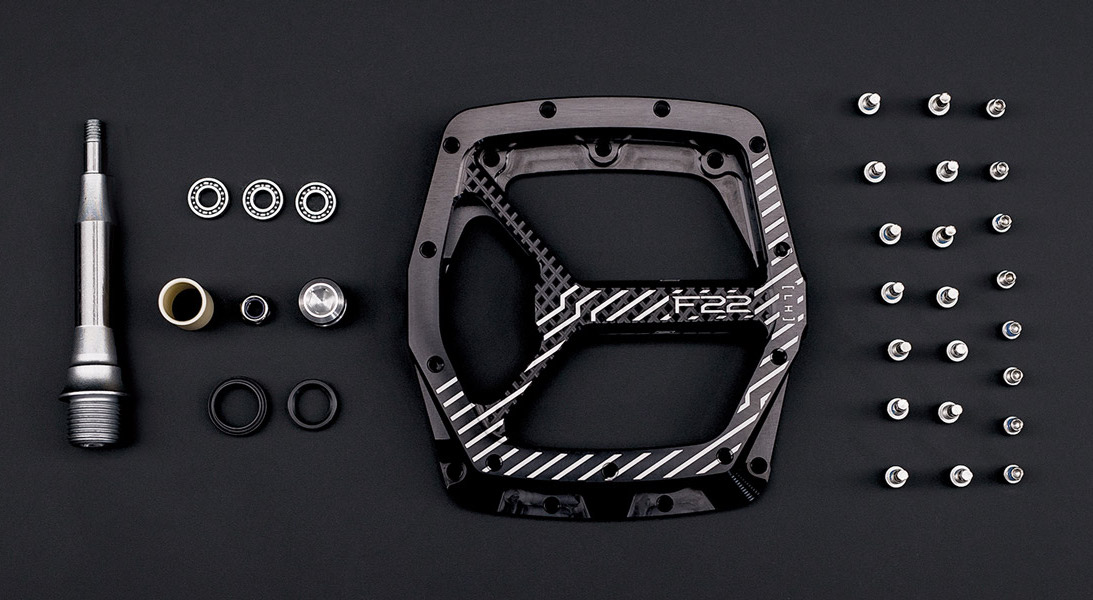
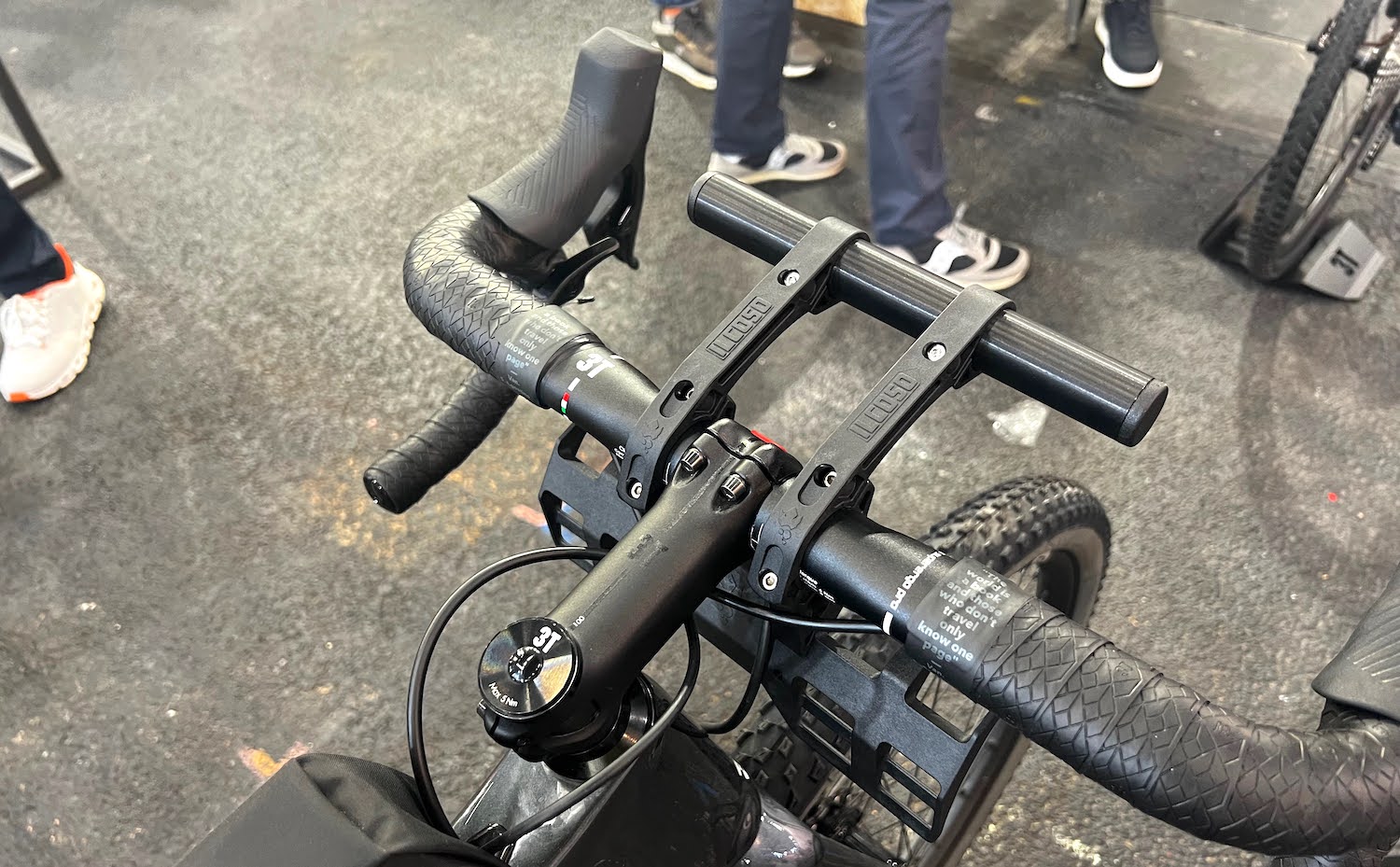

Wow! Thanks for doing this testing! I am a dyed-in-the-wool front/back traveler; I have noticed a difference with panniers of course, but have always thought there would be no difference due to reconfiguration.
I wonder if a fairing of some sort would change this result …
ohhh mama! if I go touring jam not interested in watts, speed, and other stupid numbers. I enjoy beautiful nature…
thank you for doing this. I am planning on Paris-Brest-Paris in 2019 and this is very useful!
This is a real interesting analysis. Carrying luggages and being autonomous is the priority when traveling by bicycle, but being effective also allows to finish early at the end of the day, or allows more kilometres for the same time on bicycle.
These concerns return your test and your analysis so interesting. On the other hand, have you already led a test of comparisons of tires (thickness, weight, type of tread, etc.). We conceive that on bad road, big tires will return more security and more pleasant riding. But what about on the paved roads and in good condition? Normally, the narrower, lighter tires and with 100 psi of pressure should return the more rolling and more effective bike. Gatorskin 700×28 pi or 700×32 just weigh 360-420 grams, Scchwalbe Marathon weighs more of double ( 960 grams on 700×38!).
According to your experience, has these differences of weight and aerodynamism a significant or minimal impact, in a context of a bike loaded with its 4 panniers, for a journey of several months, with for a main target of paved roads and in good condition?
——
Pour information, we will start again on our tandem, this time for a two years trip down to South America and come back. More details here: http://tandemetcie.com + http://www.crazyguyonabike.com/doc/NormandetHelene
Thanks again for all these so great and interesting informations on Cyclingabout.
Normand, Hélène
Beloeil, Québec-Canada
One thing worth mentioning is that while on a velodrome you experienced quite steady conditions the overall drag of panniers in windy conditions will require additional power to maintain the same speed. The stronger the headwind the more time and energy you might loose on a 100km stretch.
Very nice test. I’m wondering about the total capacity of the bikepacking set, as another interesting number would be the “L/s” slowdown :-). The bikepacking set is the fastest but the others have more room, but how much more?
Me too, but I couldn’t help but wonder…
Fairings most definitely would change the results!
Pack light, travel fast! 🙂
Good point. Windy conditions would favour the most aerodynamic setup.
I haven’t completed any tyre testing specifically, but according to most data – a wide tyre on a touring bike that’s travelling at low/moderate speeds will roll just as fast, if not faster than a narrower tyre. You’ll indeed get the additional comfort and grip too.
Aerodynamics+weight play a pretty insignificant role in the context of a long tour because bike touring is not really about speed or time. Take what you’ll use, set everything up to be practical and enjoy your time on the road!
Have a wonderful time on your big Americas trip.
The bikepacking set I used was about 25 litres, but you can get bikepacking bags that will accomodate 40+ litres – the equivalent of a set of rear panniers.
Great article and test, thanks for the effort. Neatly set out and written.
It was predictable, the difference, but I would’ve thought it could be even more pronounced. Panniers must really act as a wall next to your bike as one travel forward. Especially in a head wind. But, as you rightly mention, one usually travel slow so that would explain the smaller differences.
It still is very useful to keep in the back of the mind, when you prepare for touring. Tyres with low rolling resistance, pumped stiff and with a neat pannier setup you could create the change between having 60 km days ending dead beat, or doing 80 km days and still feel up for that beer.
My geek/nerd friend got me to this site, and this the first post I’m reading, “five minutes on a hilly 100km ride” … I understand one can be so passionate about cycling they want to analyse everything, but they risk missing the point I’m afraid.. I’ll stick to http://tomsbiketrip.com much closer to my worries (quest of a meaning of life)
Interesting test! Glad you took the time to do it. It’s also worth noting that with the capacity of panniers, folks will naturally fill them with things they don’t necessarily need (I know I did when I traveled with F/R panniers through Latin America). So a hidden benefit with bikepacking bags is the limitation. If you can’t pack it you won’t, and if you are like me, you’ll be all the more happy in the end. And, that will affect speed and ride enjoyment more than anything. IMO.
12 minutes hardly seems earth shattering, In a race certainly but who the hell is in a hurry touring?
Thank you for yet another substantiated comparison. The Internet is full of subjective views and such (rare) comparisons with true data are most valuable.
Have you considered a similar drag test comparing panniers with trailers? This would put some more fuel on the pannier vs. trailer discussion… 😛
The large randonneur bags act somewhat as a faring. Jan Heine (Bicycle Quarterly) ran similar tests to yours and also a wind tunnel.
I like front loading myself. Because style!
A number of friends of mine tour with just rear panniers (ortblieb back roller classics) and a small handlebar bag for their camera and wallet. They tour a lot in Asia (hotels + camping) and they chose for rear panniers instead of a bikepacking setup since rear panniers are easier to take on and off the bike and easier to carry. Plus if they need
to carry extra stuff (for example food) they can easily do so by putting it in a plastic bag and bungy cording it to the back rack.
My friends setup (rear panniers + back rack + small handlebar bag) weighs approx. 2,5 kg
A bikepacking setup (frame bag + seat bag + handlebar bag) weighs approx. 1 kg.
According to your tests, that extra 1 ½ kilo won’t slow you down very much but the bikepacking bags are more aerodynamic than rear panniers by more than 6%.
My question is: For off-pavement riding (gravel, hard packed dirt roads and singletrack – where aerodynamics doesn’t really matter) – how does the ‘bike handling’ of a bikepacking setup (1kg bags + 9kg gear – weight centrally placed but higher on the bike) compare to the ‘bike handling’ with a set up of rear panniers + handlebar bag (2,5k bags + rack and 9 kg. of gear weight lower on the bike yet hanging off the side of the bike)?
Of course a bikepacking setup is easier to squeeze through brush but then again their pannier set isn’t as wide as their handlebars so I’m guessing both setups can’t speed throughthick brush.
Otherwise – is there any other ‘bike handling’ difference between the two set ups when cycling off road?
For the majority of my touring, speed isn’t a consideration. But on the odd occasion when I’m tied for time, I like to complete a route in a shorter time period. And that means thinking about things like aerodynamics and weight. 🙂
I was pretty close to pulling out a trailer for the test. But in the end, I decided that there were a few more variables associated with running the trailer than I’d have liked for this comparison. Perhaps I’ll run a test between four panniers and a trailer soon, comparing the same capacity (eg. 70 litres) and weight (eg. 25kg).
Definitely. It’s so easy to go nuts filling panniers!
You’re right – all of the small gains add up to allow you to ride further with less effort.
Hi Grace.
In my experience, the handling difference is pretty minimal when you’re not needing to change direction often. On most dirt roads, that means almost no handling disadvantage when using panniers as you generally take long, sweeping turns. If you’re riding more singletrack, or needing to weave along rocky roads then the centralised nature of bikepacking bags will be advantageous.
Alee
Awesome, thanks for doing science! Only thing is, 30kph is more like racing speed than touring speed. I typically tour around 20-22kph, where I suspect a lot of these differences completely disappear.
Also not sure I’d agree that 17 minutes over 100km is “a lot” – but that’s subjective.
Anyone who has a train to catch in a few hours 🙂 Found myself in that situation recently, had just over 4 hours to ride 85 km to catch a train (after having already ridden 90km with a massive climb). Pretty glad I had a bikepacking setup. Ended up making my train by 6 minutes, with basically no stops.
It’s my pleasure! You’re right, I can ride my bike pretty fast, so people riding slower than me will experience reduced aerodynamic benefits.
17 minutes is certainly not a lot on most people’s watches. But when you consider that it’s the same disadvantage as carrying 20kg extra, I think that strikes a chord with most people!
Although you’re comparing 20kg on a hilly course with the flat course in this trial. *shrug*
Nice set of measurements, thanks for doing and documenting this!
Following what Alee writes about volume, on https://www.cyclingabout.com/complete-list-of-bikepacking-bag-manufacturers/ using the data from ApiDura I see handlebar + saddle bags are 20 + 17.5 = 37,5 l. Two Back-roller classics are 40 l so that is about the same but adding two front bags gives you an additional 25 l. Frame bags can be added in both setups and add almost no drag while you can easily access it during your ride so always a good idea.
Honesty, I do not like the typical bikepacking setup too much, especially the saddle bag. If drag is important to you why not have a rear carrier and put everything on top of that; that is behind your body so probably almost no additional drag.
These measurements were done with a speed around 30 km/h. Assuming 25 Watt of the 200 Watt is used to conquer rolling resistance (and that rolling resistance is constant with speed) and knowing the drag scale with speed^3, you can calculate that the bikepacking setup gives 100 Watt drag + 25 Watt rolling = 125 Watt at 25 km/h. For 20 km/h it boils down to 51,1 + 25 = 76,1 Watt and for 15 km/h it is 21,6 + 25 = 46,6 Watt.
Assuming the same powers, the bikepacking setup at 25 km/h translates to 23,4 km/h for one bag and 23 km/h for two bags. For 20 km/h, on bag is 18,7 km/h and two bags 18,4 km/h; for 15 km/h one bags is 14 km/h, two bags 13,8 km/h.
I’ve never used panniers but makes me wonder about designing more aerodynamic shapes for them, some wedge shape with slicker stiffer outer walls.
Aerodynamic panniers exist. I’d say they haven’t taken off because speed and aerodynamics tend to be a pretty low priority for most people, but there is a market for them in the recumbent circles. Check out the Angletech panniers (http://cycledifferent.lightspeedwebstore.com/angletech-techwind-panniers/dp/1000000040) – they claim to be 7% FASTER through the wind than a bike without panniers!
Brunswick velodrome? Just near my place.
Sure is!
Great comparison but it would have been nice to include a “hybrid” set-up that many of us use these days: front handlebar harness or small front rack with 20L dry bag, frame bag, rear rack bag like the Arkel Tailrider (or a saddlebag) and two lightweight, smallish rear panniers like the Arkel Drylites on a Tubus Logo. The best of both worlds! The Drylites don’t stick out much from behind your legs so they’re pretty aerodynamic yet give you easier loading and another 28L capacity.
Better aerodynamics means less effort and more energy to enjoy nature when you get there!
Great job. I have been thinking about doing this type of experiment of years, so kudos dong this! I had figured frame bags would give some big advantages over the standard setup.
In terms of front loading, I suspect running the panniers higher up may be more aero than in the low rider position as it will be a better wind break for your legs, which disturbs a lot of air and therefore have high drag.
It would also have been interesting to run a control (bike without any gear) too see how far frame bags are off the mark of a naked bike.
Tire casing is a huge confounding factor with wider tires. Most wider tires have very stiff casing (puncture protection, sidewall armour) which really slows down how they roll.
Tried some very light/supple 700×38 tires (compass) and I was gaining about 1.5 km/hr avg over more standard stiffer touring tires (700×42). Although not velodrome tested…
Aerodynamics has two main factors, frontal surface area and drag coefficent. The bikepacking bags are all inside the frontal area of the rider. Panniers are not. That makes a big difference. And the front handlebar bag probably helps according to the wind tunnel tests Jan Heine did at University of Washington’s windtunnel. I suspect a bikepacking seatpack may help as well as it fills the turbulent tail area somewhat.
I used the Tailwind front panniers back in the 1980s. Very subjective I suppose, but I never noticed added drag (I also had a handlebar bag and a tent on the rear rack – around 20 pounds added weight). Yes, the wind tunnel tests down by Glenn Brown at the time showed lower drag than no front panniers. Mind you, at 5 inches wide, the increase in frontal area is pretty small compared with regular panniers such as the Ortliebs. In addition, they are in clear air helping to divert air flow around churning pedals dirty air space. In general, wind screens placed in front of riders of bicycles and motorcycles reduce drag – in the cases of full frontal fairings, over 10 percent. Enclosed fairings do even better.
I spent around 2 years total bike touring in my twenties with this set up and have to laud the lowrider front pannier set up. My bike was completely stable bombing down mountain passes at 40 mph, so much so that I could ride hands off. I traded off a few times with other tourists I met who usually had rear panniers only. Those felt unstable at low speeds leaving me with no confidence at all.
I’ve just found your site. Good thing too as I’m building a new bicycle and plan to go on extended tour this winter down under. While I haven’t read everything on your site yet, I’d be interested to know if you’ve commented on the riding stability of various combinations of bags.
bags on the back were in riders slipstream but same bags low out front had same drag, so low bags are better?
went from hardtail mtb with 26″ x 1.75″ schwalbe marathon plus tires to road bike with 700c x 1.1″ schwalbe marathon plus tires. wow the road bike is so easy to push … getting some lowrider front racks and ortlieb front roller panniers.
And what’s more enjoyable than being out riding in beautiful country with great efficiency and comfort! Thanks for these tests – I’ve been wondering about these exact questions.
Perhaps I missed it, but this testing is missing a volume component. The bikepacking bags do not hold anywhere near the capacity of the front and rear panniers. Absolutely they are more aerodynamic, but you are sacrificing a lot of storage capacity. Depending upon the distance and duration of your travel, this may be a non issue, but I think it bears mention.
As I was wanting to compare the speed difference between a single set (2) and both sets of panniers (4), volume was omitted for obvious reasons.
Hi Mike, one small correction: rolling resistance does not change with speed but the power does, as it is resistance x speed.
Thanks for the thorough analysis. Couple of thoughts… Would a riding position adjustment (on the drops) more than make up for the panniers? How about a bike trailer like extrawheel or Bob? These should be more aerodynamic with bob being heavier but having a bit of a fairing to deflect the wind… would make for an awesome follow up.
The interesting thing with riding position is that the aero results are quite different between bike and rider setups. But to get a general sense of the difference between the hoods and drops we can look towards the Specialized Win Tunnel Test. It determined that there’s a 5% drop in drag when in the drops compared to the hoods. That could mean as much as 2km/h (12 minutes) at my speeds, or indeed, the difference between panniers and bikepacking bags. That said, the key here is that you can comfortably maintain that body position all day!
I’d love to test four panniers vs. a trailer one day.
Great answer. I’m thinking that the drops will be useful when in a hurry, riding fast and or into a nasty head wind. In some cases this will be for some time but I wouldn’t say all day. I’m thinking it’s a useful trick to keep up your sleeve for a few hours when in a bind.
The extrawheel and similar trailers could be our biggest trick yet so I hope hope hope you get to test it.
I been thinking about this as well. Thanks for testing it out!
Hi Alee, recently found your site, what a great resource for all cycle tourers!
This is a very interesting discussion. Agree with your results 100%. I long ago anecdotally confirmed your results about aero being most important on relatively flat tours. My wife and I have toured together for many years. I am typically a bit faster than her and thus carry more of the combined load. We had done many fully loaded tours with both BOB trailers and 4 panniers with generally no trouble riding about the same pace with me carrying the heavier load.
We did our first credit card tour and she used her two full size Ortlieb rear panniers, fairly stuffed. I used a frame bag, small saddle bag, and also a very low profile Topeak rack trunk bag with very narrow fold down r. panniers. I again carried 60+% of the combined load. On the flats, she really struggled and just could not keep up, even in the draft. You could see the profile of her rear bags was MUCH wider. She got extremely frustrated!
Next tour came up and we got her the identical Topeak bag I was using. Voile! Again she was keeping up!
Would really like to see the 4 bag vs. trailer test. I have been a long time defender of BOB, endless arguments with dedicated 4 baggers who insist that the 15# weight of the trailer make it slower. I have always maintained that is not the case. I think you will find the aero advantage is pretty enormous. We have certainly had no trouble keeping up with, and have generally been faster than, many of the 4 baggers we have rode with on tours over the years. Obviously not comparing apples to apples there but still. The other huge advantage of the BOB, as I’m sure you know, is that you aren’t carrying the weight on the bike. So much easier on the bike and components, especially wheels. You can therefore use lighter and faster wheels and tires if you like. Also to me handling with a Bob is superb, once you are used to riding with it it’s like it’s not there at all, in my view superior to even the best touring bikes handling when fully loaded.
Anyhow, enough with the rant, would love to that test if you get to it!
You dont really need to maintain your positio in the drops all day, my feeling us you do that when you feel significant wind resistance …. from speed or indeed head wind. The rest of the time, enjoy.
I was in the hoods for 100% of the testing here. 😉
I’ll try and get a trailer vs four panniers test completed this year! I’m interested in finding out the results too.
Sorry for arriving late to the discussion here, but one thing I’ve been wondering but haven’t done the digging to find an answer is in terms of interference between the saddle bag and the seatpost you use, the thudbuster. Also, Specialized makes the CG-R (Cobble Gobbler). I happen to own them both on different bikes and it just seems that using saddle bags with them wouldn’t be the best idea. Then I see you used one here!
So, what are your thoughts on it?
How does this compare against us short-wheelbase recumbent riders? 😀
The Thudbuster isn’t great for bikepacking saddle bags due to it’s bulbous size. I was a bit lucky with the softly-built Revelate bag, although I couldn’t quite strap it as firm as I would’ve liked. In comparison, my Ortlieb Seat Pack is not at all compatible due to the rigid internal structure.
With respect to the CG-R, I know that Specialized made their Barra Barra saddle bag compatible with it. The Barra Barra uses a mini-rack to stabilise the bag which means that the straps don’t need to be as firm. The second-best option would be the PDW Bindle rack ( https://www.cyclingabout.com/pdw-bindle-rack-sway-free-saddlebag-for-bikepacking/ ).
Power meters are awesome. That is all.
Totally unscientific. Not the same capacity so useless results.
IMO the most important reason why I go front only when touring light isn’t speed or aerodynamics, it’s balance, particularly on the ups.
Thanks.
Agree!
I’d say you’d be a little quicker!
I like climbing with a front load too. 🙂
You could have removed the Front and Back racks when you used the bikepacking bags 😉
In an ideal world I would have used four identical bikes, with different rack setups based on the bags. But I had to make do with what I had!
Why would anyone care how fast a loaded touring bike is?
Based on the popularity of this article, it’s something that lots of folks are interested in. Why? Because they figure that if they can tweak their setups to go quicker (at the same rate of effort), then it affords them more flexibility with what they can do between sunrise and sunset.
I sometimes hook up a Bob Yak style trailer for shopping runs. I wonder whether the extra weight and drag of the tyre is countered by the improved aerodynamics of the single longer bag? Could be better for touring as well. The load isn’t added to the bike so much, and a slightly different designed trailer could use a wheel the same as the bicycle and get the load up higher so that it sits more the disturbed air flow from the rider and bicycle.
I was just wondering about the ærodynamic effects of rando handlebar bags. Can Jan Heine’s conclusions be found somewhere?
if I need to carry 20kg i tour around the globe, with all the time of the world…..
This is awesome. TY!
Do you think backpacks are more aerodynamic than bikepacking bags?
When testing the effects on weight on speed, did you increase the tire’s pressure for heavier loads?
– I’m not sure if backpacks are faster. Even if it was marginally faster, I’d much prefer having gear off my body.
– I used the one tyre pressure for the different weights. The pressure was high enough that the heaviest load didn’t collapse the sidewalls by any significant margin.
Geat article. It will be great to include a trailer in the test. Based in your experience, what do you think would be the results?
I think volume for volume, it’ll work out the same as four panniers. But I’ll do some testing soon!
For bikepacking, it would be interesting t know how much the handlebar roll affect the speed. Most of the bikepacking items intuitively look pretty aerodynamic, but in comparison, that front roll looks like drogue parachute. I wonder how it compares to placing the same things in backpack or somewhere else.
I personally believe that mounting the same front roll sideways on top of something like Arkel Tailrider Bag should lead to much better aerodynamic setup (smaller frontal area) than “traditional” saddlebag+front roll, while having the same capacity and easier access to items. But then, why nobody does so?..
Interesting thank you.
A few comments:
1 If you half the contents of the panniers, so the contain is the same as the bikepacking kit, the panniers would be much slimmer and have less drag.
2. 30 km/h is quite a high speed for touring. I normally make 20-25 km/h while on the bike and the aero drag is then a considerable lower percentage of the total. At 30 km/h aero drag is maybe 70% of the total while at 20 km/t its’ less than 50% so the aerodynamics of the whole setup has significantly lower influence.
3. I like these theoretical investigations and tests but in the end we are TOURING and I spend quite some time off the bike, so weight and aerodynamics hardly has any influence on my average distance 🙂
If I am in a hurry, I’ll take the car or a bus, not a fully loaded bike 😉
Aaaah,but when touring, you set several days aside as spares, just to make sure, there’s no hurry 😉
What is set up for the 40 Liter bikepacking?
Very interesting test, and thank you for sharing. When I go touring average speeds are much less than 30km/h – probably closer to 15 km/h, so aerodynamics would make a lot less difference. For me anyway. Worth bearing this in mind. I would be interested see a comparison energy expenditure over 100km between the various conditions, because that (rather than time) is the scarcer resource when touring. Thank you again – very interesting read.
A fair point. A bigger air profile would actually help in the case of a tailwind but that happens so rarely alas!
Given the aerodynamic drag of panniers I wonder why there are hardly any on the market with compression straps that allow you to make the side profile of the bag as narrow as the load allows. Am I missing something?
Alee, I appreciate your work and info. Re: bikepacks vs. panniers, all the results match common sense, as does your comment that a wider-ranging long-distance tour requires more equipment and thus more capacity = panniers. What I’ve not heard anyone comment on is the difference between riding a bike carrying the same weight in panniers vs. bike packs = not in terms of aerodynamics and speed, etc. but Handling. The frame is a lever relative to the tire contact patch (effectively a fulcrum point); moving the weight farther out on the lever– carrying the gear up at top-tube/saddle/stem level– increases the leverage of the frame relative to the tire contact patch. This effects handling. Comments? Thx, garyk
I’m guessing the reason you don’t really hear people doing a weight comparison (in terms of handling) is because people who use bikepacking bags will almost never carry as much weight!
I’ve only packed ultralight when using bikepacking bags to do mostly off-road stuff. I’ve find that with those kind of loads (10-15kg across all bags) the bike’s handling is very quick to adjust to.
On a side note, one of the reasons I prefer front panniers over a front basket (or porteur-style bag and rack) is for the reason you’ve pointed out; the latter butchers the handling of a bike with a similar load (10kg+).
Thanks, I think you nailed it in terms of using bike packs for light touring. My observation is I’m seeing bikes loaded/overloaded with giant seat-packs, monster handlebar rolls, over-stuffed frame in-fill bags, all trussed up like sausages, so that I want to ask, Have you ever tried panniers?! It also jumps out that I don’t see much of anything in these get-ups in the way of easy access, the kind you need constantly for long days on the road – for clothing quickly on/off, snacking, tools and cameras, etc. Whatever– I’m an old fart by now, and won’t be investing in (any more) new gear set-ups (got a garage-full of that = need some original Eclipse panniers and matching racks? Still the lightest, best set-up ever.) gmk
Panniers are undoubtedly more practical for most uses. It’s normally when you get to really rough dirt roads, or singletrack off-road trails where the bikepacking gear is the way to go.
at what mph do aerodynamics come into play? 12 ish mph ?
I guess if I was concerned about being Aero I wouldn’t be looking at 650×47 tires. interesting thoughts to consider though. Especially if its a grueling 80-100 mile ride into steady head winds. at that point, I’d probably just sit on a bench in what ever town and watch the world go by. 😉
I am still reading other arguments. Bikepacking is winning, due to a more centered load, lighter load. Panniers is winning because of the ease/simplicity of packing. panniers is losing because who wants an extra 8 pounds in racks and bag weight? This argument also is tipping the slider one way or the other towards choosing between tour vs gravel bike. As in if I went the pannier route then I’d choose Vaya, or Sequoia, Awol etc…. bikepacking = Carbon Norco search XR, Cannondale Slate. Norco Search XR could do it either way.
I am also not sure I am the frame bag kind of guy. Choices……
If you’ve still got the power files from this experiment, have you considered doing a Chung test? It would make your results a lot more accurate, and it would be interesting to see what you got. You can download a free program called Golden Cheetah (google it), import your power file and as long as you can identify each lap of the velodrome (usually pretty easy from the data itself), it can do an accurate calculation of your aero drag coefficient, which you can use to calculate time saved.
I’m off on a world tour soon and will definitely be heading to the velodrome to test my setup, so I can reduce my drag and finish each day as relaxed and refreshed as possible!
Unfortunately, I don’t have the files anymore. Thanks for the heads up on Golden Cheetah!